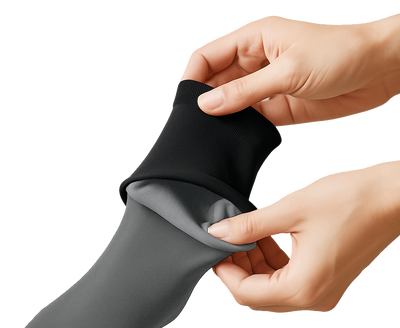Kidney disease and Edema in Legs

We decided to dedicate this May to edema. Edema is an important topic because many different factors can contribute to developing it, thus making it a wide, and common problem.
In the past articles, we talked about edema in pregnancy (a problem that affects ¾ of pregnant women), edema caused by heart failure, and lymphedema. In this article, we will be covering yet another factor of edema – kidney failure.
With this article, we will close the edema topic, but we hope it could also help you in the future if you ever experience a problem like this.
What is Edema?
Edema is swelling caused by water retention in the tissue. It can happen in different many parts of the body, but most commonly, edema develops in the limbs. Arms and legs have the most problems with blood circulation, which makes them the most affectable by edema.

The good thing is that you can treat edema in limbs with compression garments, such as compression socks.
Edema is a bodily response to an injury or a trauma, but it can also be a symptom of much bigger diseases, such as heart failure or kidney disease.
It is important to know all the factors that can contribute to a problem that you are experiencing. But maybe even more important is to know in which cases those symptoms indicate one problem, and in which another.
It is important to stay informed, but also not to self-diagnose. If you believe there is a problem, the only right thing to do is to speak with your doctor. Self-diagnosing can be dangerous.
So, if you do have edema, it does not have to mean that you have kidney disease or heart disease. It can also be a sign of stress, poor blood circulation in your legs, wrong diet, etc. Please, leave the diagnosis to the professionals, and plan from that on.
Why is an Edema associated with Kidney Disease?
Kidney disease and edema are often associated because edema can be one of the symptoms of kidney problems.
When you experience kidney failure, the kidneys are unable to process the extra fluid from your body. That is when the extra fluid builds up in certain parts of the body causing swelling. The most common parts are under the eyes, legs, hands, and especially ankles. This is why ankle edema and kidney disease are most commonly paired.
Edema can also happen when there is damage caused to the clusters in the small kidney vessels. These clusters filter extra fluid and waste from your blood, which cannot be done if the clusters are damaged. These problems usually cause nephrotic syndrome, a kidney disorder that lets excess protein levels in the urine.
Nephrotic syndrome can cause advanced leg edema. Edema is one of the kidney disease symptoms that are usually more progressed and indicate a later stage of kidney disease.
Does chronic kidney disease cause edema?
Chronic kidney disease is a type of kidney disorder where a person gradually losses the functionality of the kidneys.

So, can kidney disease cause edema?
Edema is one of the symptoms of kidney disease, although it is not present during the early stages. Chronic kidney disorder has 5 stages, and the symptoms and treatment differ during them.
- Stage 1 usually doesn’t show any symptoms. The kidney still doesn’t fall under the 90 percent capacity.
- Stage 2 includes symptoms such as fatigue, sleep problems, weakness, loss of appetite. The functionality of kidneys is about 60 % - 89%.
- Stage 3 is the stage where you can first experience edema. Feet and hands can start to swell, but you can also experience back pain, frequent urinating, and all the problems from the previous stages. In this stage, the kidneys work between 30 and 69 %.
- Stage 4 means the kidney is functioning between 15 and 29 percent. The symptoms include all of the above, but also muscle twitches, reduces mental capability, chest pain, nausea, shortness of breath.
- Stage 5 means that the kidneys are functioning on less than 15 percent, or the person is already experiencing kidney failure.
Chronic Kidney disease and edema
Chronic kidney disease and lower extremities edema certainly have a connection. But, as you can see, in the early stages of the disease, there are almost no symptoms at all. That is why you shouldn’t lean on edema as a symptom of kidney disease, because there are many earlier symptoms such as fatigue.
Chronic kidney disease and the risk of pulmonary edema
Kidney disease is not a direct factor that can develop pulmonary edema. However, people with kidney disease are often believed to have a risk of cardiac problems, which can lead to pulmonary edema.
The most common cause of pulmonary edema is heart is left-sided heart disease or left-sided congestive heart failure, on which you can read more in our previous article.
Why Does Kidney Disease cause Edema?
Kidneys’ role is to filter toxins, water, sodium, and waste from your blood and to remove them through urine. This is not to let this excess water and waste build up and harm your body. When kidneys’ function decreases, they cannot filter and process all the waste and excess fluid from your blood. That is when the extra fluid and salt build up in your tissue and body, making the body swell.
Kidney disease means your kidneys do not have enough strength to process all the water and waste, and with every drop of functionality, your body collects more and more of that waste. This the reason that when a person experiences complete kidney failure, they can no longer live without dialysis.

Dialysis cannot fix your kidney, but it substitutes their function, filtering and removing the extra fluid, sodium, and waste from your body. Dialysis is something that can prolong a person’s life, usually until there is kidney transplant available for them. This is stage 5 of chronic kidney disease, or kidney failure, not earlier.
How to reduce edema from kidney disease?
Luckily, there are ways of reducing edema.
The most common precautions and remedies include:
- Reducing salt intake (because if the already excess sodium in the body)
- Using diuretics to help remove the extra fluid
- Using compression therapy garment. In the case of leg edema, compression socks, and stockings.
A solution we can offer you is our Hydrating Medical Grade Compression Socks.

The compression material will squeeze the swollen area, micro-massage it, and help break the fluid buildup. They will also help to normalize blood flow and to return the blood from your limbs to the heart. Compression therapy helps prevent injuries, reduces heaviness from the legs, and helps normal functioning.
Compression socks are the number one help with swollen feet and bad circulation, and they help the overall quality of life. By reducing one problem, we cannot solve another, but we can stay more positive and more willing to fight other problems.
Check out our online store and choose your pair of compression socks. If you want to know more about how they work, visit our article Compression socks 101.




